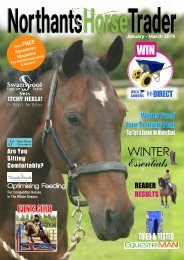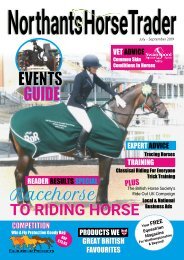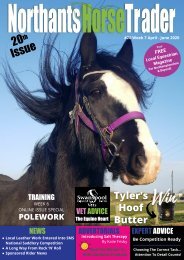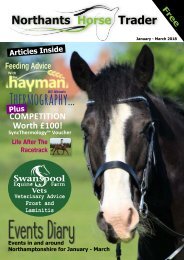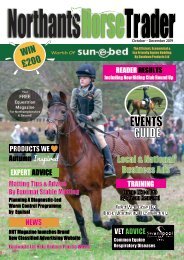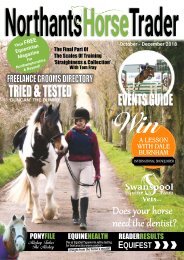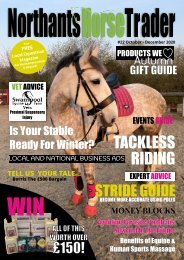NHT Magazine Summer 2018
You also want an ePaper? Increase the reach of your titles
YUMPU automatically turns print PDFs into web optimized ePapers that Google loves.
Once you feel you have achieved this you can move on to a very simple<br />
figure of 8 exercise to develop a more consistent change of bend. The way<br />
to do this is to:<br />
●<br />
●<br />
●<br />
●<br />
●<br />
Ride (in trot to start with) large round the arena, concentrating on<br />
inside leg to outside hand through the corners.<br />
Change the shape of the way you ride round the short sides of the<br />
arena to almost a half 20m circle at each end.<br />
Then start to ride changes of rein along both long diagonals, so you<br />
are constantly changing the rein with a half circle at each end, this<br />
would look like a tall thin figure of 8 rather than a round ‘bumblebee’<br />
figure of 8.<br />
As you ride the figure of 8 think about the inside leg to outside hand<br />
feeling on the half circle and then when you ride straight across the<br />
diagonal you need to ‘pick-up’ the old inside rein so you have an<br />
even feel down both reins.<br />
Before arriving at the start of the new half circle on the new rein you<br />
need to prepare the new inside rein through a few ‘feel and give’<br />
motions down the rein. As you give the rein you should back-up<br />
increased inside leg to outside hand connection by nudging with the<br />
new inside leg to the new outside hand.<br />
4<br />
1 2<br />
3<br />
●<br />
Ride the new half circle and immediately change the rein on the next<br />
long diagonal repeating the above step of picking up the old inside<br />
rein and connecting the horse from both legs into both hands before<br />
preparing the new inside rein with a series of ‘feel and give’ motions<br />
down the rein backed up with the new inside leg.<br />
As you consistently ride this exercise the horse has to remain supple<br />
through to the bit and the consistent feel down the rein become elastic<br />
through the constant change of rein and adjustment from one inside leg to<br />
outside hand connection to the other.<br />
The most important thing to remember here is that it is always leg first;<br />
contact is achieved through riding the horse forward from leg to a ‘forward<br />
thinking hand’, not a blocking hand.<br />
These exercises build on the rhythm and suppleness exercises you will be<br />
doing with your horse and help develop increased lateral suppleness as<br />
well as an improved contact.<br />
A forward thinking hand and a<br />
soft elbow allows the hind leg to<br />
swing through and push the<br />
horse forward<br />
Allowing with a soft elbow<br />
Firm hand,<br />
soft elbow<br />
Impulsion is achieved when the horse takes more weight on his<br />
hindquarters in order to perform movements with a greater degree of<br />
engagement and cadence. The image at the bottom of this page shows the<br />
relationship between the hind leg coming ‘through’ and under the horse in<br />
order for him to lift under the saddle and take more weight through his<br />
hindquarters, note the position of the head and how impulsion would be<br />
compromised by a hand that is pulling back and not allowing the horse to<br />
travel forward.<br />
A shorter rein with a forward thinking hand will shorten the frame of the<br />
horse and through the later scales of training will achieve greater collection.<br />
Let us focus on improving impulsion, essentially what we are trying to<br />
achieve is a greater degree of controlled ‘push’ from behind. The horse<br />
should bring his hind leg well under his body and take more weight on his<br />
hind leg for an increased period of time, leading to the impression he is<br />
taking a longer, slower, step with a greater degree of ‘lift’ or cadence in<br />
each step. This is developing the horse’s longitudinal suppleness, creating<br />
the ‘rainbow shape’ over his back.<br />
The moment from ‘almost’ walk into trot encourages<br />
Improved hind leg action as long as the hand allows the<br />
hind leg to come through from behind<br />
Inside flexion, soft hand…<br />
There is one simple way of improving impulsion and that is through<br />
transitions. Repeated transitions will encourage the horse to engage more<br />
from behind – the trick is to ensure the transitions are performed in an<br />
rhythmical, supple manner with a good contact – it is no coincidence that<br />
these are the first three stages of the scales of training! Hopefully you can<br />
see how things are fitting together now and how each scale affects the<br />
subsequent scale.<br />
Image credit:<br />
By Renate Blank - Klaus Schöneich Zentrum für Anatomisch richtiges Reiten® & Schiefen-Therapie®,<br />
CC BY-SA 2.5, https://commons.wikimedia.org/w/index.php?curid=1256352<br />
Continued on the next page…<br />
24





